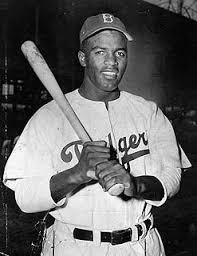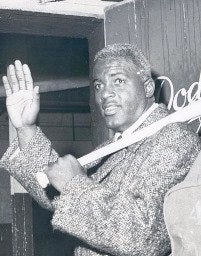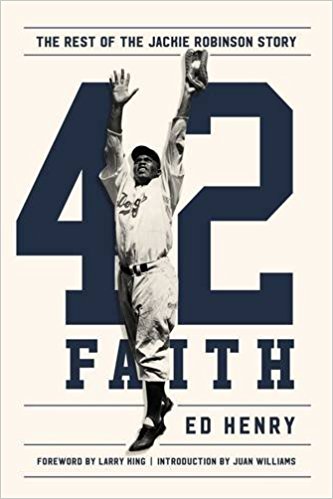|
On Saturday, every major-leaguer will wear No. 42, to commemorate Jackie Robinson, the first African-American in the majors in the 20th Century.
This will be the 70th anniversary of Robinson’s debut in Ebbets Field, Brooklyn – the beginning of a grueling season, a grinding decade. Jackie Robinson would die at 53. Many people think the ordeal heightened his diabetes, hastened his death. In a real way, he gave his life for a cause. This sense of Robinson as vulnerable point man for equality is never more relevant than in a time when Americans seem to be questioning their direction – when the Roberts Supreme Court can negate previous civil-rights legislation, letting us know that things are just fine now, we don’t need all those rules bolstering people’s rights to vote. By some cosmic happening, the Robinson anniversary and the return of baseball take place in the spring, in the time of Passover and Easter, celebrations of survival. Robinson’s own beliefs – the power that kept him going – is currently explored by Ed Henry in his new book, “42 Faith,” published by Thomas Nelson. Henry is the Fox News Channel chief national correspondent (and a friend of mine.) Henry is too young to have seen Robinson play or meet him but in his busy life he has admirably sought out people and places where Robinson’s history can be felt. Henry explores the magnetic pull of the ball park that used to be in Flatbush; the vanished hotel in Indiana where Branch Rickey gave shelter to the black catcher on his college team, the still-standing Chicago Hilton where a wise Dodger scout named Clyde Sukeforth interviewed a Negro League player named Robinson. Holy places, in a way. The story has been well told by Arnold Rampersad and Steve Jacobson and Roger Kahn, if not with this overt angle on faith: Robinson was a mainline Protestant who relied on his pastor, who taught Sunday school, who saw life through a framework of Christianity. He was sought out for the Brooklyn Dodgers by Branch Rickey, a man of religious dedication – who did not go to the ballpark on the Sabbath -- who had no qualms about wheedling his best players out of a thousand here, a thousand there. Aging Brooklyn heroes like Carl Erskine and Vin Scully recall the strength and complexity of Robinson, and aging fans recall the example of Robinson holding his natural fire, to establish himself, and his people. This was a big deal, the coming of Jackie Robinson. I remember being home in the spring of 1947 when my father called from the newspaper office to say that our team, the Dodgers, the good guys, had just brought up Robinson from the Montreal farm team, that he would open the season in Brooklyn. We (white, liberal) celebrated. Every year the major leagues celebrate with No. 42 on every uniform. Thanks to an inquiring journalist, the story goes on.
Brian Savin
4/11/2017 06:49:43 pm
Nice tribute, George, I hope the Milleniels pay attention, but I suspect many may find it hard to relate. My generation was close enough to get it. I vividly remember I saw him once in Bayonne, New Jersey, on Broadway in the sixties. I saw this guy who I thought looked like him in a brown Lincoln with a tan vynal top slow down and pass by me. He pulled into a parking spot across the street in front of a restaurant owned by my Grandmother's grammar school best friend, named Burke's. He got out and sure enough it was him. My biggest impression was that I had never seen a belly so big on a man so tall and straight. But I was in awe. I related my sighting and family told me it was him. He frequented the place from his days playing for Jersey City. Really nice guy I was told. I suspect the diabetes was his life style. I hope we remember.
George
4/11/2017 07:35:34 pm
Brian: true. I saw him under stands at Ebbets Field, '54, he was not playing and chatted with a few kids. I was surprised how heavy he was, and how gray.
Gene Palumbo
4/13/2017 12:37:59 pm
Reader alert: George has a very nice piece about Secretariat in the Times:
Hansen Alexander
4/14/2017 08:04:26 pm
Nice overview of Jackie Robinson George,
bruce picken
4/15/2017 07:26:05 pm
george,
Joshua Rubin
4/17/2017 01:04:22 pm
Nice piece on Robinson. Lee Lowenfish's excellent bio of Branch Rickey goes into a lot of detail about Rickey's thinking and strategizing about how to bring Robinson to the big leagues. 4/17/2017 05:46:36 pm
Great tribute to Jackie.
George Vecsey
4/17/2017 08:37:56 pm
Thanks, everybody, for the comments. Alan, what i 1939 led to Jackie Robinson in 1946-47? 4/20/2017 11:02:55 am
Chapter 8 in Talmage Boston's book, 1939 is called "Moving towards the Day". It includes how Marian Anderson, Satchel Page, the Negro Leagues and Wendell Smith pushed the great experiment. Comments are closed.
|
Categories
All
|












